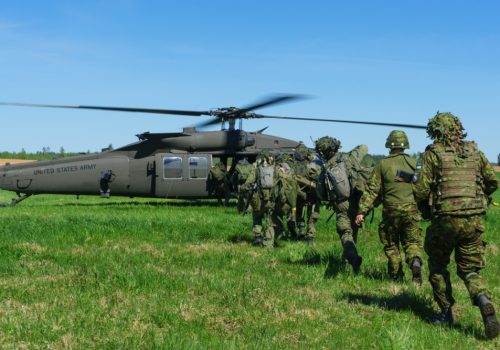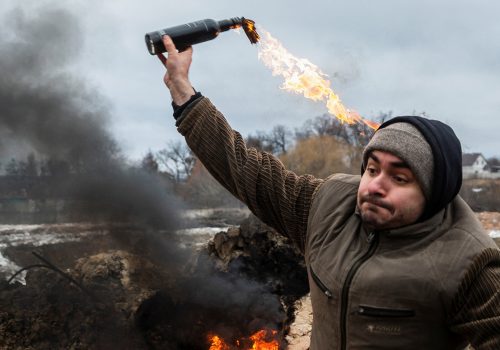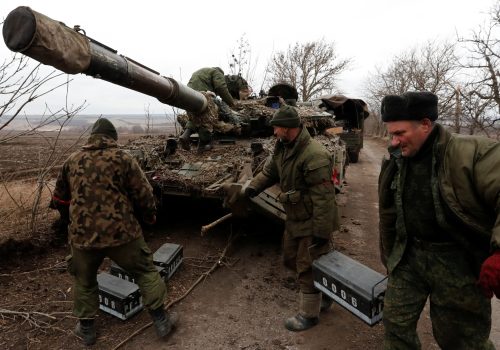Europe’s security architecture, transformed: Why Finland is now on a path to join NATO
Until last week, one of the most prominent features of Finnish security policy was continuity. Finland has stayed its course since the end of the Cold War. That has meant a steady focus on national defense and resilience in the context of the comprehensive security model. When change has taken place, it has been largely buried under rhetoric of continuity. The most important shift in Finland’s international position and its security policy took place in 1995, when Finland joined the European Union (EU). The security policy implications of the decision were largely underplayed at the time, yet it signified the end of the policy of neutrality and a clear anchoring of Finland in the West.
The other major shift in terms of security and defense policy has been a steady growth in Finland’s defense cooperation with partner countries and organizations. The Government’s Defence Report notes that “international defense cooperation strengthens Finland’s defense capability and improves operational readiness, strengthens threat prevention, and raises the threshold against military activity directed at Finland.” The foundations for today’s cooperation were laid in the early 2000s by building interoperability in the crisis-management operations in the Balkans and in Afghanistan. Cooperation started to grow more rapidly after Russia seized Crimea.
Of note, bilateral cooperation with the United States has both deepened and expanded. It still has a significant material-cooperation element to it, not least with the recent Finnish decision to acquire F-35s, but includes cooperation on technology, exercises, and, crucially, a constant policy dialogue at various levels. Bilateral cooperation with Sweden has also been steadily strengthened, and now includes joint operational planning.
Finland became an Enhanced Opportunities Partner of NATO in 2014, and has concluded cooperative arrangements ranging from the Host Nation Support arrangement to modalities of strengthened interaction in crises. The EU has constituted a key pillar of Finnish security policy since 1995. After overcoming initial worries about the EU becoming a defense actor, Finland has been a strong proponent of the EU defense dimension. Finally, Finland has joined several “minilateral” and regional defense-cooperation arrangements. Nordic cooperation in the context of Nordic Defence Cooperation (NORDEFCO) is a long-standing arena, whereas the European Intervention Initiative (EI2), Joint Expeditionary Forces (JEF), and Framework Nation Concept (FNC) are newer mechanisms.
In practice, Finland has sought strategic alignment with key partners in recent years. At the same time, forming or joining alliances has been deemed a step too far. This policy has been pursued partially to maximize Finland’s room for maneuver, even to the extent that politicians have emphasized the possibility of Finland staying outside a regional or European conflict. This line of thinking misses the fact that Finland has ratified the Lisbon Treaty, which includes a mutual-assistance obligation, as well as the fact that interdependence has grown exponentially in the last decades and that the fate of Finland is inextricably linked to that of other European countries.
This intricate balance has been evident in the so-called NATO option, which has been a mainstay, albeit a disputed one, in Finnish security and defense policy during recent years. It refers to the possibility of Finland seeking NATO membership. In the public discourse, the option has been portrayed as a clear binary and mechanistic choice between accession or staying outside NATO. Such portrayal of the issue has been common among both those supporting accession and those against it. It frames the problem in black-and-white terms, even when reality has different shades.
There is some nuance in the debate, mostly linked to two different aspects. First is the continuation of the NATO open-door policy, which has been thrown into question by Russia. The United States and NATO, as well as potential applicant countries, have responded unequivocally that it is a matter for NATO and applicant countries—and nobody else. The other aspect relates to statements made by Finnish politicians attempting to outline circumstances that might lead to Finland seeking accession to NATO. The prevailing sense has been that if the security situation in the vicinity of Finland takes a decided turn for the worse, Finland would be forced to apply for membership. The counterargument is that when the situation gets worse, it is already too late. The process would take time, exposing Finland to external influencing campaigns, and the allies might be less enthusiastic about admitting new members to the club at a time of rising international tensions.
Recently, including in President Sauli Niinistö’s New Year’s speech, the possibility to join NATO has been instrumentalized more directly than before, but the NATO option has always been a tool of statecraft. Finnish leaders have communicated to Vladimir Putin the steps that Finland could take in response to changes in the bilateral relationship or the broader security environment. The NATO option, therefore, has functioned as a deterrence tool and, as is customary for deterrents, it loses some of its effectiveness if it actually needs to be applied. On the other hand, the tool needs to be credible to act as an effective deterrent.
Recent weeks have changed the situation completely and irrevocably. Orthodoxies have been thrown out of the window, as witnessed in the recent 180-degree turn in German security policy. The discussion on Finnish NATO membership, which was previously mostly academic and stagnant, has gathered speed and intensity. The parliament debated the issue on March 1 and the topic is set to dominate the political landscape in the near future. For the first time ever, public support for NATO membership has exceeded 50 percent of the Finnish population. Individual politicians are developing their positions, to be followed by the party platforms. Finland is not Ukraine, and any direct aggression against Finland is unlikely in the near term. But, the sense of betrayal by Russia is strong. Finns will want to increase their security in any way possible, while showing unequivocally that their country stands with the West.
In an equally dramatic shift, the Finnish government made the decision to deliver arms to Ukraine. This upends long-standing policy that Finland does not export arms to countries at war. The decision was all the more pointed because those arms will be used against Finland’s large neighbor, making Finland an even more involved actor in the unfolding conflict. This was the right decision, even if all its implications for the relationship with Russia cannot yet be observed.
Conclusions from the war in Ukraine
Even with the war in Ukraine raging, it is already time to draw initial policy conclusions. The post-Cold War world order will not return, and Finland should prepare itself for the coming European security architecture. A prudent approach would build on continuity with some adaptation to the new environment, drawing on the following three elements.
First, strong defense capabilities. They are critical for deterring conventional aggression, and help drive the strategic competition to less risky areas. While Finland has tended to emphasize its independent capabilities, even those are not fully independent; they rely, for instance, on satellite-based communications systems and replenishment of stocks. These dependencies need to be managed.
Second, comprehensive security. The information domain, cyberspace, and space all continue to grow in importance. The cognitive domain will be critically important, as the functioning of the society—both in peacetime and in crisis—depends on motivated and resilient citizens. To counter threats in and across the different domains, the country needs good situational awareness and an updated process to harness the capabilities of various parts of the government and society.
Third, international cooperation. The ability of the EU to stand united and react forcefully to Russian aggression has been impressive, and gives some ground for optimism. Yet, in the longer term, the EU must increase its level of ambition and scale of efforts in the security realm to become a stronger geopolitical actor. It has a significant toolbox for countering the threats of the twenty-first century, but it needs the commitment and support of the member states. The United States would also have a constructive role to play.
Bilateral and regional cooperation will need to continue. The cooperation with Sweden should evolve to the level of integration and role sharing, and cooperation with the United States also continues to be critical. Because there are common interests in the Baltic Sea region, in the Arctic, and beyond, strategic alignment should be pursued and put into practice.
For Finland, this is a path that leads to NATO membership. Gears are already in motion with the process likely formalized after the 2023 elections at the latest—that is, unless external shocks once again change the equation. Assuming that the request to join NATO from Finland (and perhaps from Sweden as well) will be accepted unanimously by the allies, this will not be the game changer for Finland that some people hope for and others fear. Instead, it will be a natural step in the process of increased defense cooperation in the last twenty years. It will bring a new set of treaty guarantees, and increase the deterrent against nuclear threats. At the same time, Finland has a way to go to understand the internal dynamics of the alliance and figure out its own position in it. In any situation, Finland needs to keep a strong focus on its other partnerships.
These elements would be the building blocks in outlining a holistic model for Finnish policy in the new European security architecture. It needs to take the increased interdependence into account, underlining the need to cooperate more closely at the European level. The threats must be faced with a united front, and with a large toolbox that enables horizontal escalation. NATO membership would provide increased deterrence against conventional and nuclear threats. The transatlantic link remains crucial, because the United States engages Europe through its role in NATO, but also bilaterally and in other formations. EU-US cooperation will grow in importance as autocracies keep coming at the transatlantic community with a mix of hybrid attack vectors. Finnish-US defense cooperation could be taken to the next level by creating structured mechanisms for operating together when the situation requires.
Besides the more structured modes of cooperation, other types of cooperation continue to hold potential. This is well in line with the current Finnish policy of emphasizing the role of ad hoc coalitions and common interests as a basis for cooperation in crisis time. The impediments to effective decision-making in larger organizations are real, and well understood.
The bilateral relationship between Finland and Russia is all but dead for the moment. While it wasn’t blind to Russian policy until now, Finland feels betrayed by the recent actions. The relationship will need to be mended at some point because geographic realities remain, but the next years will be a reckoning during which Finland will anchor itself even more securely in the West.
Rasmus Hindrén is the head of international relations at the European Centre of Excellence for Countering Hybrid Threats and a nonresident senior fellow in the Scowcroft Center’s Transatlantic Security Initiative. He is a former civilian official in the Ministry of Defence of Finland, where he served as deputy head of unit for defense cooperation. The views expressed here are the author’s alone and do not reflect the policy of the Finnish Government.
Related content
Image: Joint press conference by NATO Secretary General Jens Stoltenberg and the President of Finland Sauli Niinistö



